Hibiscus plants are grown for their large tropical blooms that come in a wide array of bright colors. It is these attractive flowers that draw most people to this plant, and you will often find these blooms on various tropical clothing, such as swim shorts and Hawaiian shirts.
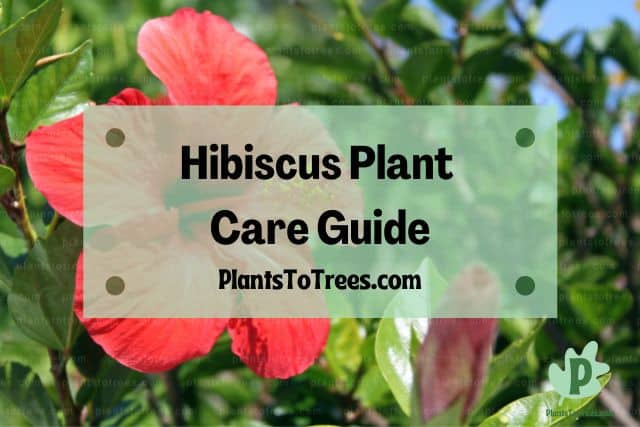
The hibiscus plant care guide is a wonderful tool to help you familiarize yourself with the growing requirements of this plant. Tropical hibiscus plants love an abundance of sun, moist but not soggy soil, and warm temperatures. There are even hardy hibiscus that can tolerate frost and low temps.
Because of the sheer amount of different hibiscus varieties available, it can be difficult to determine what type of growing requirements it needs. Thankfully, even if they have different temperature requirements, almost all of the cultivars and varieties of this stunning plant need direct sun and regular watering.
Other Names Of Hibiscus Plant
While hibiscus is how most people know this plant, it isn’t the only name it goes by. Let’s look at what other names some people call the hibiscus.
Hibiscus is most well-known by that name, but it does have a couple of other names that some people call it. Rose of Sharon, for example, is another common name that hibiscus is sometimes called. Other names include tropical hibiscus and hardy hibiscus.
Frost Tolerance And USDA Hardiness Zones Of Hibiscus Plant
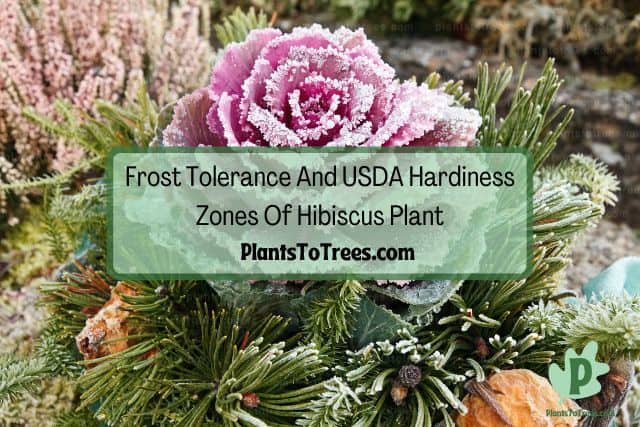
For people living in the United States, the USDA hardiness zone lets you know whether or not a plant, such as the hibiscus, can grow outdoors in your climate. Even if you cannot grow it outside, however, that doesn’t mean you won’t have the option of growing it indoors as a houseplant.
As its name suggests, tropical hibiscus grows in tropical, warm climates and cannot tolerate cold or frost. It grows in USDA hardiness zones 9 to 12. There is, however, a hardy hibiscus that can grow outdoors in USDA zones 5 to 9, and is frost tolerant, handling cold temps as low as -20 degrees.
How Many Hours Of Sunlight Does Hibiscus Plant Need?
The amount of sunlight a hibiscus plant receives is another vital piece of information that anyone wanting to grow this plant needs to know. After all, not providing it with the right amount can result in an unhealthy plant that doesn’t bloom to its full potential.
Tropical hibiscus need at least 6 to 8 hours of sun daily, but giving the plant more is ideal since it loves an abundance of sun. The more sun the hibiscus gets, the more flowers you will see blooming. While it can tolerate some shade, too much will reduce the blooms.
Hibiscus Plant Needs Direct Or Indirect Sunlight?

Should the plant have direct or indirect sunlight is one of the most common questions that people wonder when growing hibiscus indoors.
Tropical hibiscus thrives in lots of direct sunlight. In fact, the more direct light it can get, the more blooms it will produce. Hardy hibiscus also need direct sunlight for at least 6 to 8 hours a day.
If, however, you are in an area where the summer gets extremely hot, giving the plant some shade during the hottest part of the day can help hardy versions.
Is Hibiscus Plant An Indoor Plant, Outdoor Plant Or Both?
Because of the sheer amount of different types of hibiscus plants available, you are sure to find a variety that works best for your specific needs.
A hibiscus can be grown indoors, outdoors, and potentially both, depending on the type. Tropical hibiscus can grow as an outdoor plant in USDA zones 9 and above, while also used as a houseplant in lower zones. Hardy hibiscus grows outdoors in lower zones, but is not often used as a houseplant.
What Are The Indoor Lighting Requirements For Hibiscus Plants?
Because the hibiscus plant is a tropical, sun-loving plant in its native habitat, you will need to find an indoor location where the plant can get the same amount of sun as if it was growing naturally outside.
Tropical hibiscuses grown indoors need a spot near the sunniest window in your home. This location will give them the abundance of light that they need for a healthy life. You can place them in an area where they won’t get as much sun, though this will affect the amount of blooms they produce.
What Are The Outdoor Lighting Requirements For Hibiscus Plants?
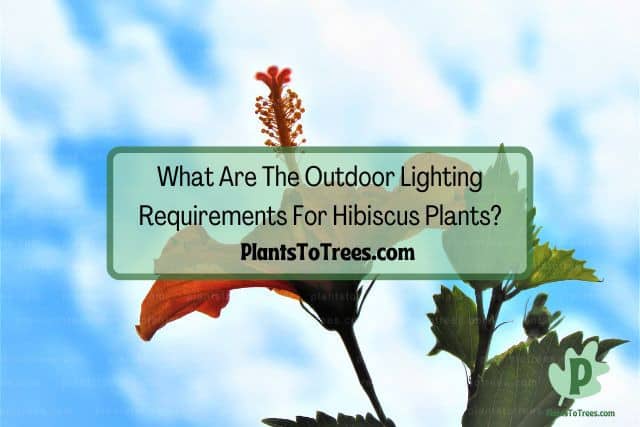
Whether you grow the hibiscus indoors or out, you should still try to give the plant its ideal lighting requirements.
Outdoor hibiscus plants need full sun for the best growth and most blooms. Hardy hibiscus plants can also benefit from a little shade during the hottest part of the day if you live in a climate that has extremely hot summers.
What Soil Requirements Does Hibiscus Plant Need?
The type of soil that you decide to grow your hibiscus plant is not something you should take lightly. After all, the soil has a direct connection to how healthy and well a plant grows.
The hibiscus plant needs soil that is rich in organic matter, while also draining well. The ideal soil mixture will also be a little acidic. You can increase the soil’s acidity level by adding peat moss to the soil mixture.
How Much Water Does Hibiscus Plant Need?
Like other plants, the hibiscus will need to be watered, but the exact amount can be tricky to determine. This is because a lot of different factors affect how much or how often you should hydrate the plant.
Hibiscus plants grow the best when their soil is moist but not soggy. Established plants usually do well when they are watered about once a week, although the size, age, climate, and even season can all alter this watering timeline.
Is My Hibiscus Plant Overwatered, What Are The Symptoms?
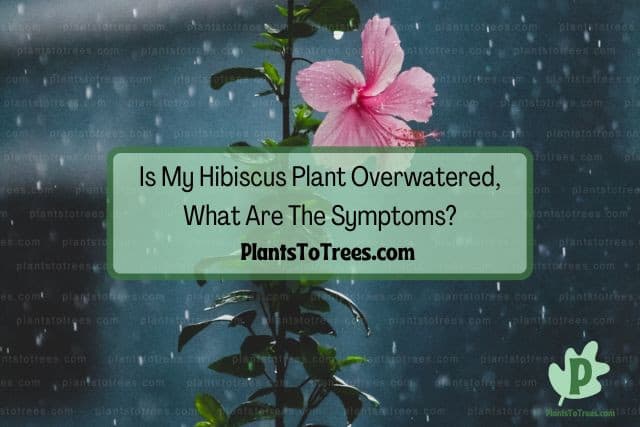
Overwatering can quickly cause your once healthy hibiscus to rapidly decline. If the overwatering continues, the plant will develop fungal diseases, which will eventually kill it. Let’s look at the most common symptoms of an overwatered hibiscus plant.
Overwatering a hibiscus can have a serious impact on the health and life of the plant. It will cause the entire plant to become a limp, soggy mess. Stems will become soft, blooms and leaves will wilt and fall off, and rot will start to form on the base, crown, and roots of the plant.
Because overwatering is a serious problem that leads to root rot, which is hard to get rid of, care must be taken not to overwater your hibiscus.
Is My Hibiscus Plant Underwatered, What Are The Symptoms?
Underwatering a hibiscus isn’t nearly as harmful as overwatering, and can generally be corrected quickly. With that said, however, underwatering can still cause serious problems for hibiscus and even prevent the plant from growing and producing blooms.
The most common signs of an underwatered hibiscus are a wilted plant, yellowing or browning leaves curling up at the edges, dry and crispy foliage, and leaf drop. You will also notice that the plant’s growth has become stunted and the soil is extremely dry, pulling away from the edges of the pot.
Once a plant has become severely underwatered, simply watering it as you normally would won’t work since the water pools up on the surface of the soil or runs off it. Instead, you will need to soak the plant, from the top of its pot to the bottom, by submerging it in a bucket of water for about 20 to 30 minutes.
How Much Fertilizer Does Hibiscus Plant Need? What Kind?
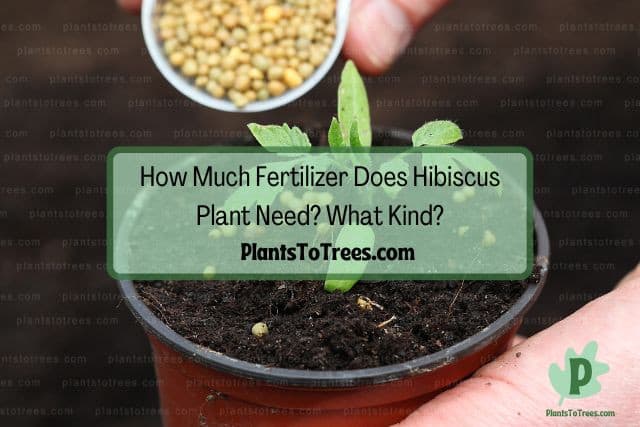
Hibiscus plants grown indoors, as well as outdoors, can both benefit from regular applications of fertilizer during the plant’s active growing season, which is during the spring and summer months.
The type of fertilizer used for the hibiscus plant depends on the time of year you are applying it. In the spring, when new growth starts to appear, fertilize the plant with a liquid balanced feed, such as 10-10-10. For the rest of the plant’s growing season, apply 12-4-8 fertilizer once a month.
Hibiscus Plant Diseases To Be Aware Of
Hibiscus plants are generally thought of as healthy and strong, with few disease problems. That doesn’t mean they can never develop diseases, and you should know which ones to look out for just in case.
The two most common diseases to watch out for in hibiscus plants are dieback disease and wilt disease. Dieback disease is caused by a fungus or bacteria that can enter the plant via a break in the stem, while wilt disease is caused by a pathogen that gains access to the plant via its roots.
Dieback disease typically only affects one part of the plant, which is the part with the injury. It can cause the affected part to wilt. It is this limited wilting that is often noticed. Once you notice only a portion of the plant has wilted, look at the stem and if you see a spot on the wood that has rotted or deteriorated, then you know the hibiscus has dieback disease.
The good news is that it can be treated easily and is rarely fatal. Simply cut the infected parts of the hibiscus off and then seal it with grafting or canning wax that has been sterilized. This will help prevent the hibiscus from being reinfected via the new cut.
Wilt disease, which is also called root rot, occurs when a fungus begins to reproduce in the soil and then enters into the plant through its roots. You should act quickly if you suspect wilt disease since this problem is usually fatal for the hibiscus plant. Unfortunately, even with treatment, the plant can succumb to the disease. That is why prevention is the best defense against this fungal problem. Avoid overwatering the plants and regularly clear away leaf litter from the pot.
We at Plants To Trees first published this article on November 4, 2022. Copyright protected.
Are There Different Types Of Hibiscus Plant?

Hibiscus is a rather large species of plant that boosts hundreds of different varieties. One thing that these varieties have in common is that they produce that iconic large bloom that most people easily recognize as a hibiscus flower.
Hibiscus plants have a wide array of varieties. Some are tropical, growing in USDA zones 9 and above, while others are hardy, tolerating temperatures that fall below zero degrees. There are even annual and perennial varieties, and they are available in various sizes, shapes, and bloom colors.
How To Propagate Hibiscus Plant
Propagating a hibiscus plant is a fairly easy process that can be done via a stem cutting. This method works for both the tropical and hardy varieties, and is a wonderful way to increase your plant load or as a fun gift for friends and family members.
When propagating a hibiscus, try to wait until summer to take a stem cutting, and only do so from health plants. Snip off a stem, cutting it diagonally, that is about 4 to 5 inches long and has several healthy leaves attached. Remove all the leaves except for the top 2 or 3.
Dip the cut end in rooting hormone and then either plant the cutting in the soil or in a jar filled with water. Set the cutting in indirect sunlight, and care for it as you would the parent plant. For cuttings that are rooting in water, change the water once a week. After about 4 weeks, roots should begin to grow.
The article owner is Plants To Trees dot Com and this article was first published on November 4, 2022.
Is Hibiscus Plant Toxic To Humans?
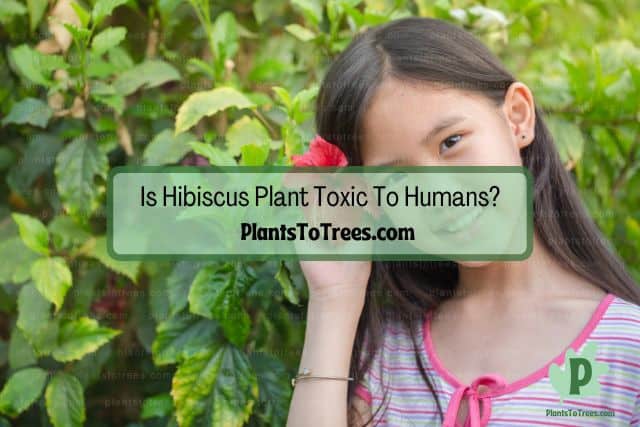
Even though they may look innocent, a lot of the most common and beloved houseplants are considered toxic to humans. But what about the hibiscus? Does this sun-loving plant pose a risk to your family?
Hibiscus plants are not toxic to humans. In fact, no part of this plant, which includes the flowers, leaves, stems, and roots, is toxic. This makes the hibiscus plant a safe option to have in your home even if you have babies, toddlers, or older children.
Is Hibiscus Plant Toxic To Dogs?
As dog parents, part of your job is to ensure the things you have in your home won’t pose a risk to the health of your four-legged friend. Unfortunately, many species of houseplants can cause harm to dogs if they ingest them.
Whether or not a hibiscus plant is toxic to dogs is a bit complicated, since most of them pose little to no threat to your furry friend. However, the Rose of Sharon (Hibiscus syriacus) is considered toxic to dogs and can cause nausea, vomiting, and diarrhea if they consume any part of the plant.
Is Hibiscus Plant Toxic To Cats?
Cats are known for their ability to get into things even if you think you have put it up and out of their reach. While this is a quality that cat parents are well aware of, it doesn’t mean you shouldn’t try to protect them from potentially harmful items, such as houseplants.
Some varieties, such as the Rose of Sharon, are listed as toxic to cats, while other hibiscus varieties are not. Because of this, it is best to keep your feline friends away from all types of hibiscus plants just to keep them safe.
Related Articles
How To Fix Dracaena Plant Stem Or Root Rot
PlantsToTrees.com is the owner of this article and we first published this on November 4, 2022.
